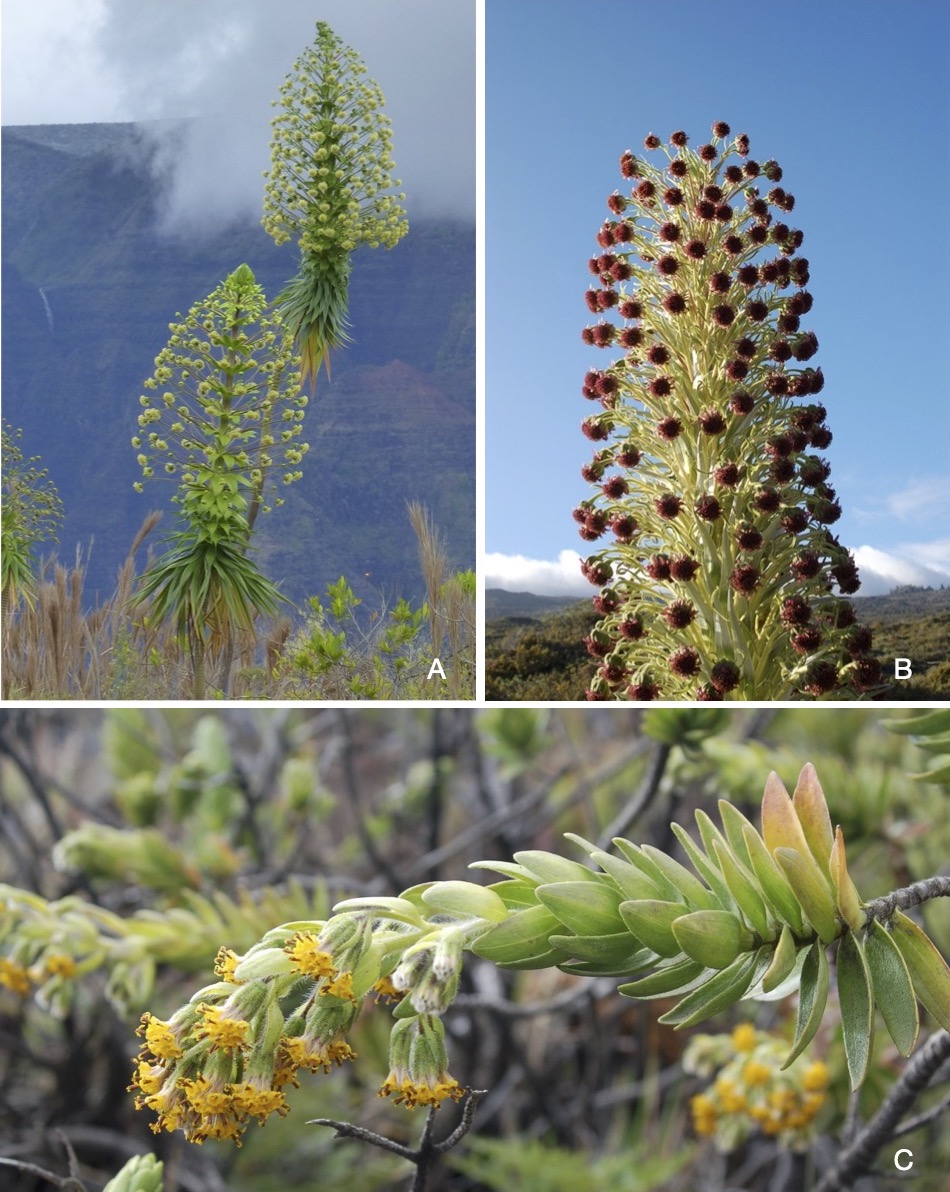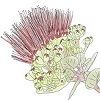10.1: Native plants
- Page ID
- 59269
Hawai‘i is a special place with diverse ecosystems such as alpine deserts, ocean coastlines, dry shrublands, and rainforests. Learning more about the plants and the different environments present in the Islands can enhance our relationship with nature and our role in island sustainability. Humans have strong connections to plants and animals. We depend on them for food and medicine, and they are utilized in cultural practices, stories, and belief systems. A great way to get to know the place we live is by knowing local plant names and their stories. How did they get here? Who or what brought them in? What is their significance?
While strolling anywhere in the Hawaiian Islands, we may find ourselves surrounded by an astonishing diversity of plants. However, not all the plants that currently inhabit Hawai‘i are native to Hawai‘i. Every single plant you find has a different history: some evolved here; some are found elsewhere on the planet but arrived in Hawai‘i without any human assistance, and others were brought by humans.
A species is considered native when it naturally inhabits a region and arrived there without any human assistance. Native plants are divided into two categories: endemic and indigenous. Endemic plants are plants that are only found naturally in a specific area and nowhere else in the world. These terms are used anywhere on the globe. For example, a plant that is endemic to China grows naturally only in China. An example of a Hawaiian endemic plant is koki‘o ‘ula (Hibiscus clayi) which does not naturally occur anywhere other than Hawai‘i. Indigenous plants are native plants that can be found in a specific area as well as in other locations. For example, naupaka kahakai (Scaevola taccada) is a plant that naturally grows in Hawai‘i, but also grows on other Pacific islands (Figure \(\PageIndex{1}\)).
Hawai‘i has 1,606 species of native plants, divided as follows:
- 421 non-vascular plants (Staples and Imada, 2006; Staples et al., 2004)
- 146 ferns and 15 lycophytes (Ranker et al., 2019)
- 1,039 angiosperms (Price et al., 2018).
The flora of Hawai‘i is very unique compared to other parts of the world, with 88% of those species being endemic to the Hawaiian Islands.
How did plants originally get to Hawai‘i?
The Hawaiian archipelago is one of the most isolated places on Earth. It is located 3,700 km (2,300 miles) from the coast of the United States and 5,863 km (3,643 miles) from Asia. Plants in Hawai‘i evolved in isolation from people and other influences for 47 million years (Gustafson et al., 2014). This long history of isolation coupled with the many diverse environments on the islands gave rise to a great diversity of endemic species evolving from the original plants that arrived in the archipelago.
The Hawaiian archipelago was created by volcanic activity. A stable hot spot beneath the ocean floor releases magma while the Pacific plate moves northwest over it. This creates seamounts underwater that eventually break the surface and become islands. As the plate moves away from the hot spot, the hot spot starts creating another island under the ocean. This is why islands away from the hot spot such as Kaua‘i, O‘ahu and Maui no longer have active volcanoes while Hawai‘i’s volcanoes are still active, and those farther away from the hot spot are smaller, due to erosion of the once massive shield volcano islands. The hot spot has already started creating a new island called Lōʻihi, east of the island of Hawai‘i that is still submerged (Figure \(\PageIndex{2}\)). Some cultural practitioners call this island Kamaʻehu (“reddish child”).
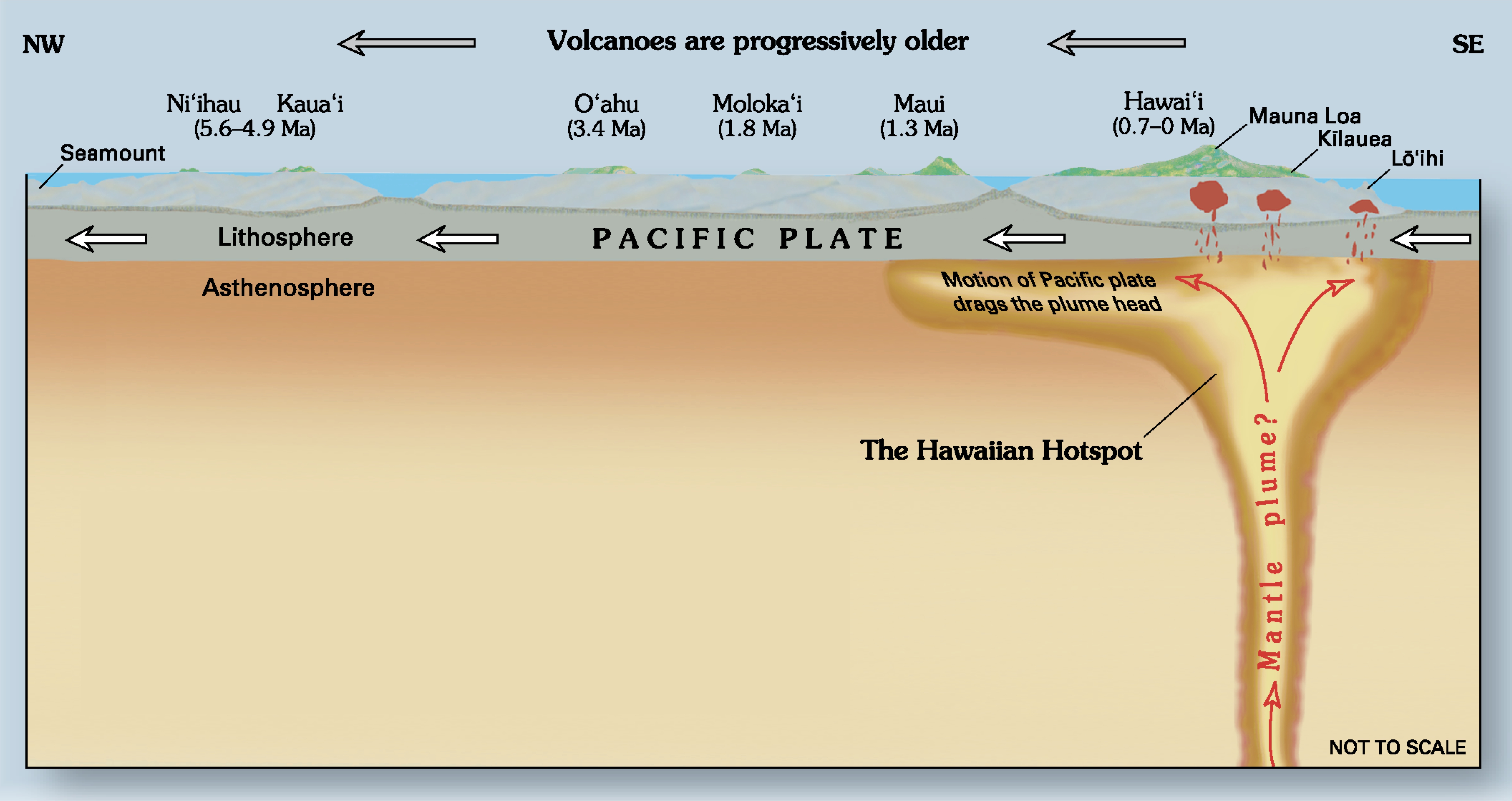
When the first plants arrived in the Hawaiian Islands millions of years ago, they encountered a land devoid of vegetation. These plant arrivals were rare; for flowering plants (angiosperms), it is estimated that there were only 259 colonizing events. These original 259 events gave rise to the 1,039 species we have today (Price et al., 2018). These species originally arrived in Hawai‘i carried by wind, water, and wings (birds).
Wind (1.4%)
Transportation by trade winds and storms is responsible for the arrival of the smallest percentage of ancestral species. This is probably because seeds or spores have to be light enough to be carried by the air, and need to be able to survive the very cold temperatures in the upper atmosphere. Ōhiʻa lehua, Metrosideros polymorpha, seeds likely arrived in Hawai‘i carried by the wind, as they are small and light.
Water (17%)
Plants also arrived in Hawai‘i attached to clumps of soil and wood (rafting) or by floating in the ocean (oceanic drift). To do this, their seeds had to float and be able to survive long-term saltwater exposure. One example is naupaka kahakai (Scaevola taccada), which is naturally found in coastal environments and has fruits that float in saltwater.
Wings (83%)
The most successful way for plants to reach the Hawaiian archipelago was by catching a ride with a bird. Sticky fruits and seeds could attach themselves to a bird’s feathers or even to the bird’s feet with the help of some mud. Seeds and fruits could also be eaten by birds elsewhere and end up in Hawai‘i after passing through the bird’s digestive system.
Where did early plants come from?
Some people are very interested in figuring out where the plants that gave rise to the Hawaiian flora came from. Plant ʻcolonizers’ arrived from different parts of the globe (Figure \(\PageIndex{3}\)).
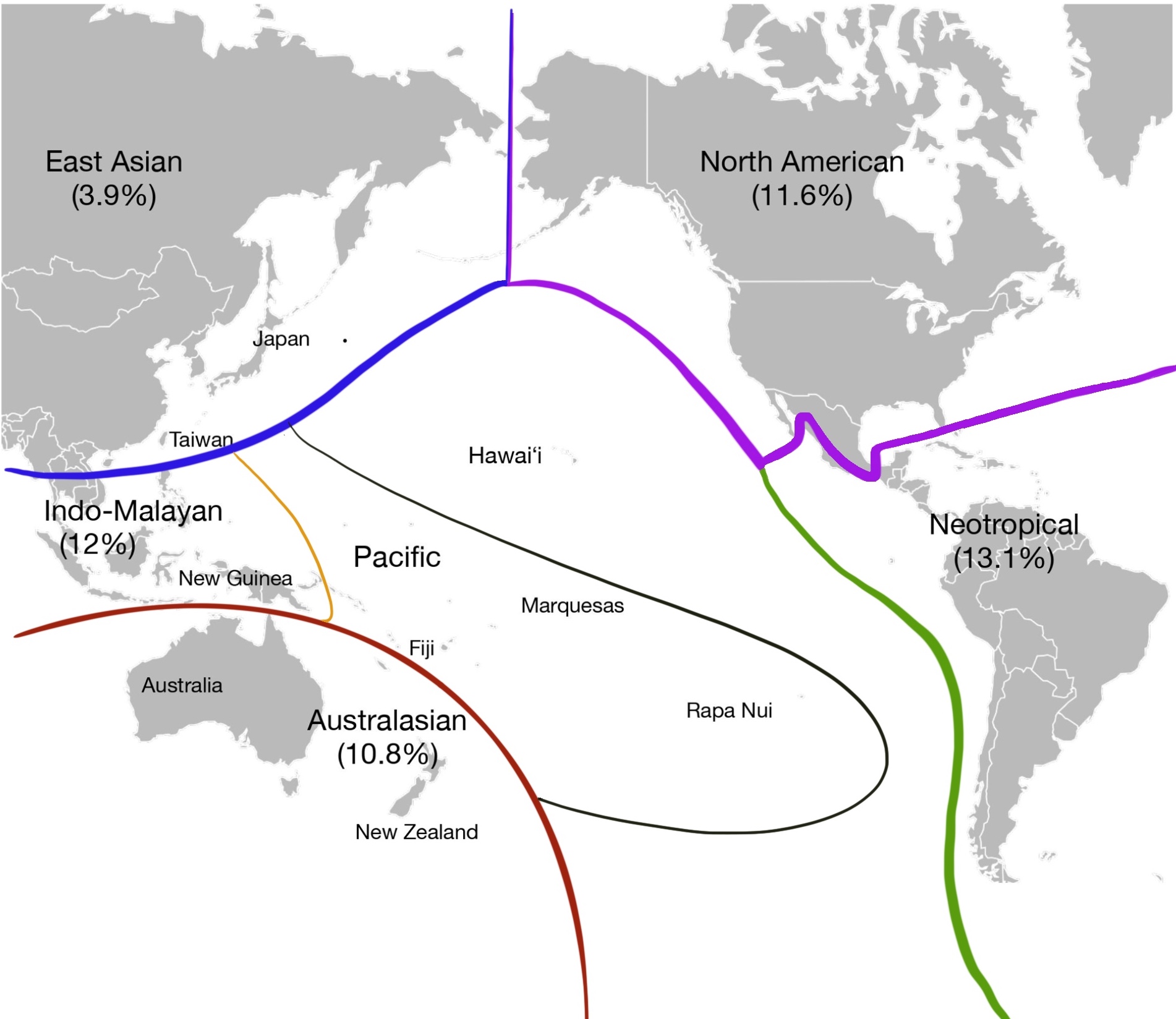
Some plants arrived directly from their home regions while others “island hopped'' arriving on other Pacific islands and then eventually getting another ride to Hawai‘i. Some of these plants (30%) are native to more than one region and are therefore classified as “widespread”. Below are the descriptions for each region along with the percentages for the plant colonists that arrived in Hawai‘i from each source:
Australasian (10.8%)
This region includes Australia and New Zealand which is 6,832 km (4,245 miles) from Hawai‘i.
Indo-Malayan (12%)
This region includes tropical areas of South and Southeast Asia. It encompasses the Malay Archipelago, New Guinea, and nearby islands. This region is 5,841 km (3,629 miles) from Hawai‘i.
East Asia (3.9%)
This region includes non-tropical areas of Asia. This region is 5,863 km (3,643 miles) from Hawai‘i.
Neotropical (13.1%)
This region includes tropical regions of Mexico, and Central and South America. This region is 4,648 km (2,888 miles) from Hawai‘i.
North American (11.6%)
This region includes the non-tropical areas of North America. This region is 3,631 km (2,256 miles) from Hawai‘i.
Widespread (30.1%)
If the colonist species comes from more than one of the regions above, then it falls into this category.
Unknown (18.5%)
A large percentage of plants have unknown origins and fall into this category.
Pacific
This area includes the islands of Fiji 4,715 km (2,930 miles), the Society Islands 3,937 km (2,446 miles), and the Marquesas 3,398 km (2,111 miles). This area serves as a series of stepping stones for island-hopping species. Plants may arrive in one of these islands from one of the regions included above, and eventually arrive in Hawai‘i by one of the dispersal methods (likely by birds or oceanic currents).
How did early plants colonize Hawai‘i?
Besides having some of the characteristics discussed above that helped plants get to Hawai‘i, they also needed traits that once here allowed them to settle, compete, reproduce, and flourish in their new environment. These plants are often referred to as “early colonists” because they were the first ones to arrive. Some of the characteristics early colonists had were self-pollination, fast growth, and adaptations to coastal environments. Plants that were able to self-pollinate had a clear advantage because the chance of finding another plant of the same species in the same place at the same time for cross-pollination to occur was quite small. Plants that were able to produce seeds without the need to pollinate with another plant of the same species were one step ahead in the game.
Fast-growing plants are often considered “weedy” because they can grow fast and in environments that are not very specific or ideal. For example, they will grow on sandy soils without a lot of nutrients. For the plants arriving in Hawai‘i, being annual (only living for one year), or being able to complete their life cycles relatively quickly, was a good way to establish new populations faster.
Finally, plants that were adapted to coastal environments (Figure \(\PageIndex{4}\)) often had an advantage. Since the largest percentage of plants arrived in Hawai‘i with birds, many of them seabirds, they had to be able to grow near the coast where seabirds spend much of their time and, therefore, are most likely to deposit the seeds they inadvertently carried. Initially, each of the Hawaiian Islands was barren with very little or no vegetation. Eventually, some of the arriving plants were able to move inland, but originally they had to survive in the coastal environments. An example of a plant that originally arrived in a coastal environment and made it to higher elevations is naupaka kahakai /beach naupaka (Scaevola taccada) which is an indigenous species. This species is also native to several Pacific islands. There is another naukaka species, naupaka kuahiwi/mountain naupaka (Scaevola gaudichaudiana) which grows in wet forests of higher elevations. This species is endemic to Hawaii. It likely originated from naupaka kahakai through speciation (a process in which populations of a species split and become new species).
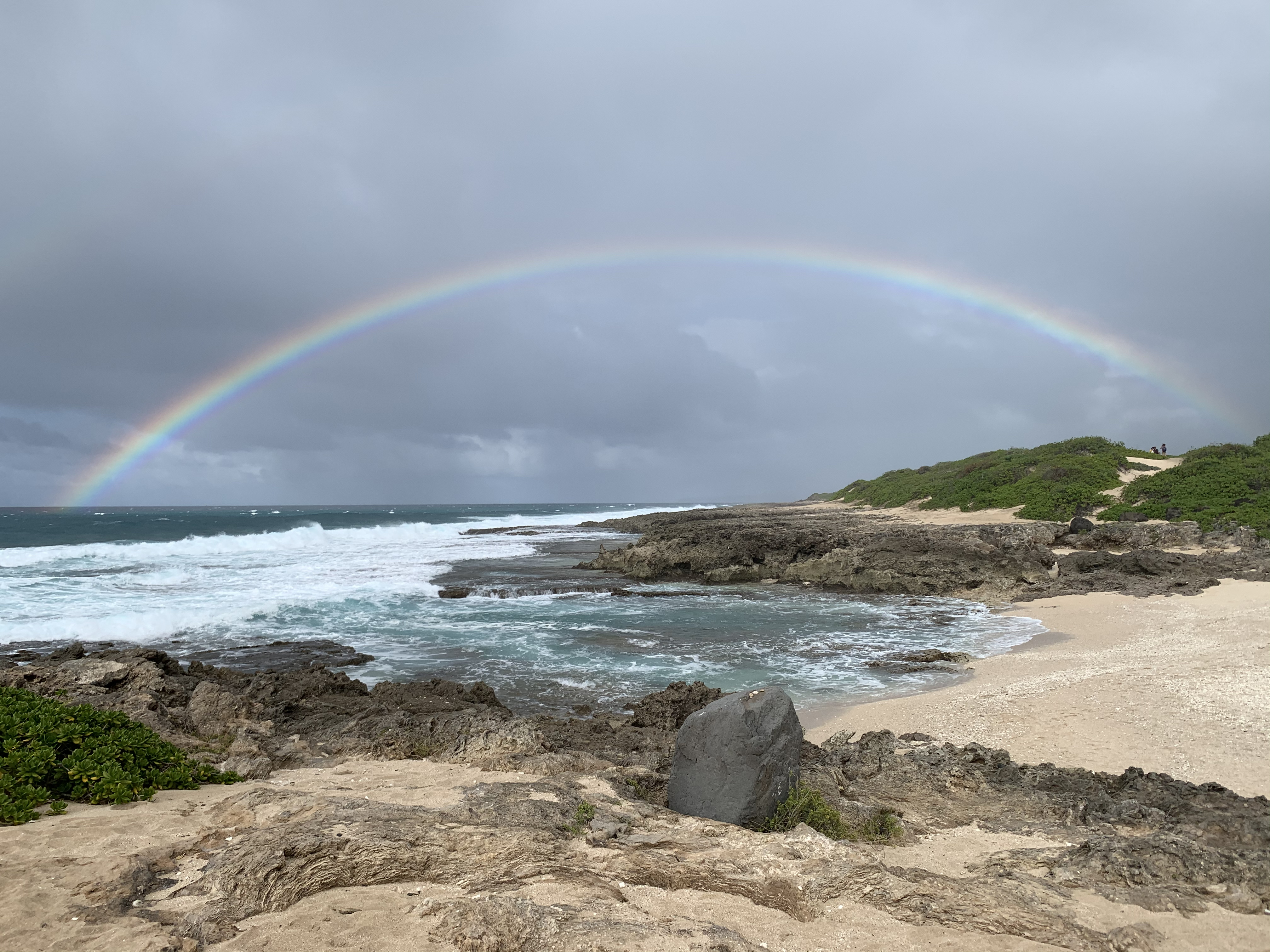
Some plants did not arrive in coastal areas but likely got deposited by birds directly in high-elevation areas. For example, the Hawaiian raspberry, ‘ākala (Rubus hawaiensis; Figure \(\PageIndex{5}\)), likely arrived in Hawai‘i from North America in the digestive tract of birds (Carlquist 1974; Morden et al., 2003).
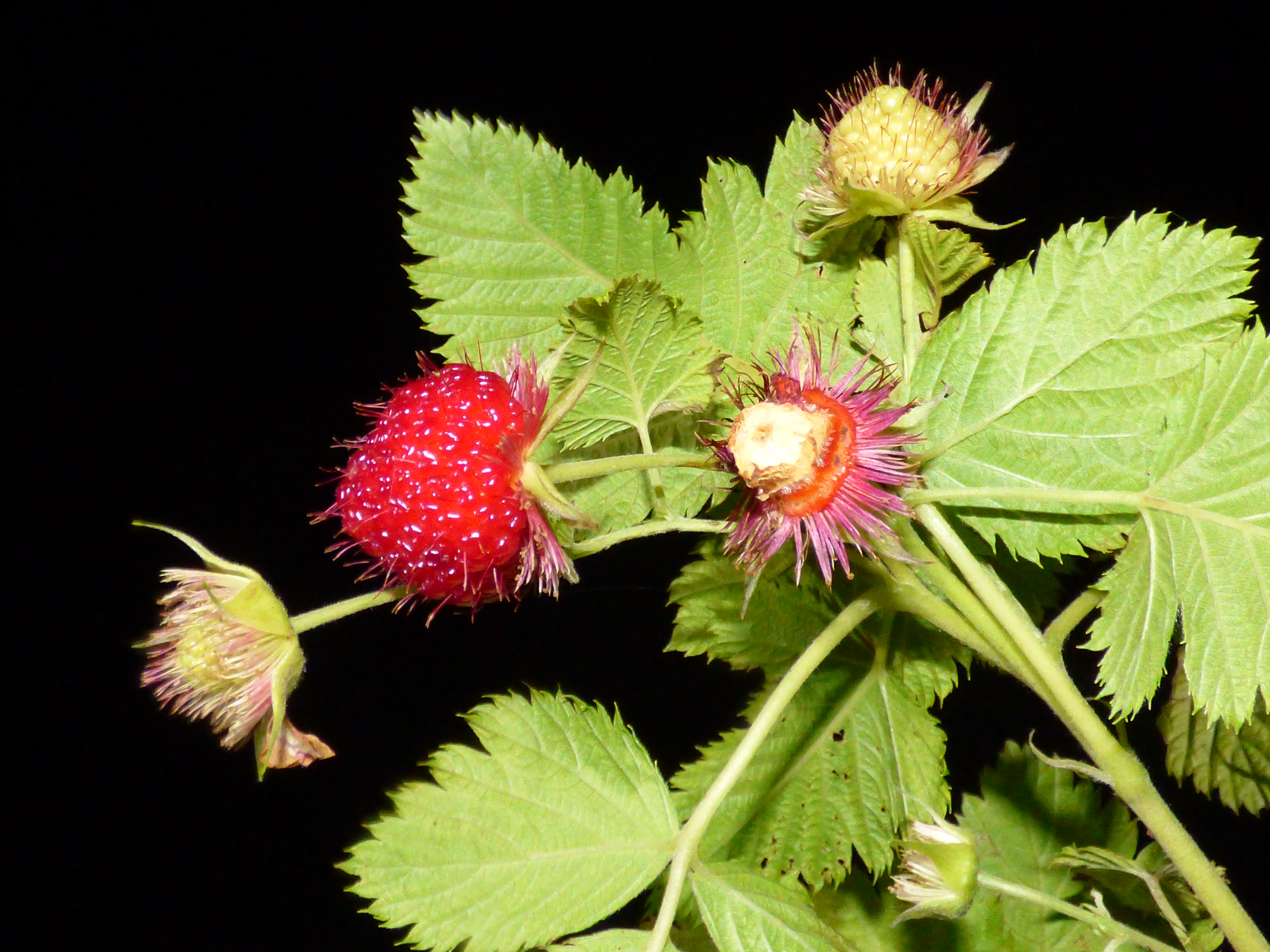
Once in Hawai‘i, these early plant colonizers diversified because they encountered new and different environments. They eventually dispersed from coastal areas and moved inland towards the mountains, became isolated from their original populations, and often evolved into new species. Approximately 88% of the native Hawaiian plants are endemic, all derived from those early colonizers who were able to arrive, survive, and establish populations here. For example, one colonizer species in the Lobeliad group (Campanulaceae family, Figure \(\PageIndex{6}\)) gave rise to 126 new species, and the Silversword alliance (Asteraceae family, Figure \(\PageIndex{7}\)) likely originated from one colonist species that came from California and diversified into 30 new species (Price, 2004).

When you compare the native flora of the Hawaiian Islands to the flora of the mainland source regions, you will notice that several families of plants are missing (a concept called disharmony; Christian et al., 2019). This is because not all seeds and spores were able to make the long trip to get here. Also, as discussed above, seeds had to be salt tolerant to survive floating in oceanic currents, small enough to travel in air currents or have the right shape and size to be carried by birds. A mango seed, for example, could never reach Hawai‘i, because they are not salt tolerant and are too heavy to be carried by a bird or by air currents. Therefore many plant families are not naturally present in the Hawaiian Islands.
